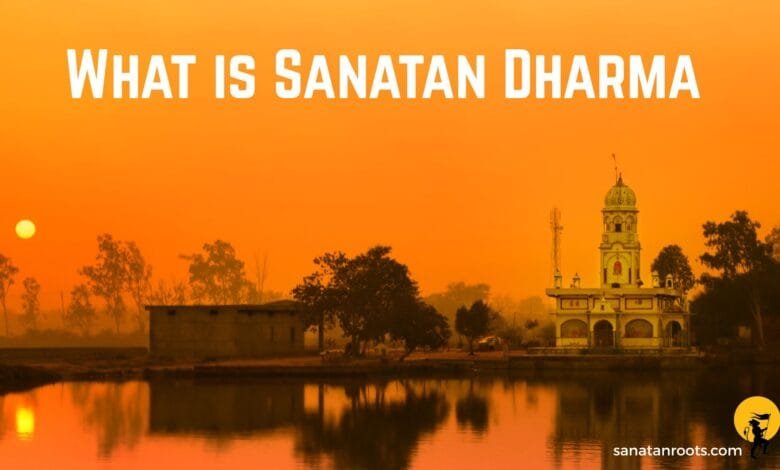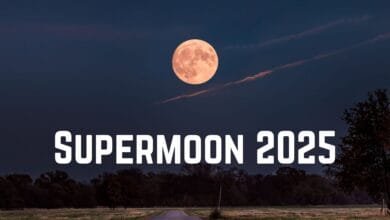What is Sanatan Dharma: The Eternal Path Beyond Religion

I’ll never forget the moment I first heard the term “Sanatan Dharma.” I was sitting in a small bookshop in Varanasi, watching the evening aarti on the Ganges through a dusty window, when an elderly scholar leaned over and said, “What you call Hinduism is just a word. What we’ve practiced for thousands of years—that’s Sanatan Dharma. The eternal way.”
His words stayed with me, nagging at the edges of my understanding. What is Sanatan Dharma, really? And why does it matter in our modern, fragmented world?
Let me take you on a journey through one of humanity’s oldest living philosophies—not as a religious scholar or a guru, but as someone who’s spent years trying to understand what makes Sanatan Dharma so profoundly different from everything we typically think of as religion.
The Name That Contains Worlds
Before we dive deeper into what is Sanatan Dharma, let’s break down the words themselves, because language here is more than mere vocabulary—it’s doorway into an entire worldview.
“Sanatan” comes from Sanskrit, meaning eternal, everlasting, or that which has no beginning and no end. It’s not eternal in the sense of “very old” but eternal in the sense of fundamental—like the laws of physics or the nature of consciousness itself.
“Dharma” is trickier. We often translate it as “religion” or “righteousness,” but both translations miss the mark. Dharma is closer to “the natural order of things,” “cosmic law,” “duty,” “purpose,” and “truth” all rolled into one. It’s the way water flows downhill, the way a seed becomes a tree, the way consciousness expresses itself through form. Dharma is what holds the universe together.
Put them together, and Sanatan Dharma means something like “the eternal natural order” or “the timeless way of living in harmony with existence itself.”
Already, you can see we’re not talking about a religion in the conventional sense.
What is Sanatan Dharma? Not What You Think
Here’s where things get interesting. When people ask what is Sanatan Dharma, they’re usually expecting an answer that sounds like: “It’s a religion founded by So-and-So in Such-and-Such year, with these specific beliefs and that particular holy book.”
But Sanatan Dharma has no founder. No single prophet. No exact starting date. No central authority. No one book that contains all its wisdom.
This isn’t a bug—it’s a feature.
Sanatan Dharma is more like an ocean than a bottle of water. It contains multitudes. Within its vast embrace, you’ll find austere ascetics and ecstatic dancers, strict vegetarians and ritual meat-eaters, those who worship God with form and those who meditate on formless consciousness, philosophical debates that would make Western philosophers weep with joy and devotional songs that bypass the intellect entirely.
How can such diversity exist under one umbrella? Because Sanatan Dharma isn’t about enforcing uniformity. It’s about recognizing the underlying unity within diversity—the eternal truth that manifests in infinite forms.
The Core Principles: What is Sanatan Dharma Built Upon?
While Sanatan Dharma doesn’t have rigid dogmas, it does rest on certain foundational understandings. Think of these less as commandments and more as observations about how reality works.
The Eternal Self (Atman)
At the heart of what is Sanatan Dharma lies a radical proposition: you are not merely your body, your mind, your personality, or your story. Beneath all these temporary identities exists your true self—the Atman—which is eternal, unchanging, and ultimately identical with Brahman, the infinite consciousness that pervades everything.
This isn’t a belief you’re supposed to accept blindly. It’s an invitation to discover through direct experience. Meditation, contemplation, and self-inquiry are the tools. The destination is the realization: “I am That.”
Karma: The Law of Cause and Effect
Karma isn’t divine punishment or some cosmic scoreboard tallying your good and bad deeds. Understanding karma is essential to grasping what is Sanatan Dharma at its practical level.
Karma simply means action, and the law of karma states that every action creates ripples. These ripples might come back to you in this lifetime or another, in obvious ways or subtle ones. You’re not a victim of fate; you’re participating in an intricate dance of cause and effect.
This understanding creates profound personal responsibility. You can’t blame God, the devil, or circumstances for your life. You’re the author, whether consciously or unconsciously.
Reincarnation and Moksha
The journey of the soul doesn’t begin at birth or end at death. What is Sanatan Dharma’s view on this? The soul cycles through countless lifetimes, accumulating experiences, working through karma, evolving in consciousness.
But this isn’t meant to go on forever. The ultimate goal is Moksha—liberation from the cycle of birth and death. Not because life is bad, but because the soul is meant for something greater than endless repetition. Moksha is realizing your true nature as Brahman, as infinite consciousness itself.
It’s not about going somewhere after you die. It’s about waking up to what you’ve always been.
Dharma: Your Unique Path
Here’s where what is Sanatan Dharma becomes deeply personal. Your dharma is your unique purpose, your particular way of contributing to the cosmic order. It’s determined by your nature (svabhava), your stage of life (ashrama), your position in society (varna), and your individual gifts and challenges.
A warrior’s dharma differs from a teacher’s. A student’s dharma differs from a householder’s. There’s no one-size-fits-all morality here. What’s dharmic for you in your circumstances might not be dharmic for someone else in theirs.
This is why Sanatan Dharma can seem paradoxical from the outside. It honors both the absolute truth (paramartha) and relative truth (vyavaharika). Both the transcendent and the practical.
The Texts: Where Wisdom Lives
When exploring what is Sanatan Dharma through literature, you encounter not one holy book but an entire library spanning thousands of years.
The Vedas
These are the oldest texts—so ancient their origins blur into legend. Four collections (Rigveda, Yajurveda, Samaveda, Atharvaveda) containing hymns, rituals, philosophical speculations, and knowledge of every kind. The Vedas are called “shruti”—that which was heard—because sages supposedly received them in deep states of consciousness, not authored them.
The Upanishads
If the Vedas are the roots, the Upanishads are the flowers. These philosophical dialogues explore the deepest questions: What is consciousness? What is reality? What is the relationship between the individual and the cosmos? Reading the Upanishads is like eavesdropping on humanity’s most profound conversations with itself.
The Bhagavad Gita
Perhaps the most accessible and beloved text for understanding what is Sanatan Dharma in practical terms. Set on a battlefield, it’s a dialogue between the warrior Arjuna and his charioteer Krishna (who happens to be God incarnate) about duty, action, devotion, knowledge, and liberation.
The beauty of the Gita is that it doesn’t present just one path. It honors karma yoga (the path of action), bhakti yoga (the path of devotion), jnana yoga (the path of knowledge), and raja yoga (the path of meditation). Choose what resonates with your nature.
The Epics and Puranas
The Ramayana and Mahabharata aren’t just stories—they’re teaching tools. Complex characters face moral dilemmas, make choices, and face consequences. The Puranas expand this universe further with cosmology, mythology, genealogies of gods and sages, and practical guidance.
These texts don’t command; they illustrate. They work on multiple levels—as entertainment, as moral instruction, as encoded spiritual teachings, as cultural preservation.
The Gods: A Thousand Faces of One Truth
Here’s where what is Sanatan Dharma really confuses outsiders. Look at a Hindu temple, and you might see dozens of deities—Shiva, Vishnu, Brahma, Durga, Lakshmi, Ganesha, Hanuman, Saraswati, and countless others.
Is Sanatan Dharma polytheistic? Monotheistic? Pantheistic?
The answer is: yes, all of the above, and none of the above.
The sophisticated understanding is that all these deities are different faces of one infinite reality—Brahman. They’re not competing gods vying for your worship. They’re doorways, each offering a different approach to the divine based on your temperament and needs.
Need courage and strength? Connect with Durga. Need wisdom and knowledge? Saraswati is your guide. Need to overcome obstacles? Ganesha specializes in that. Need devotion and divine love? Krishna or Rama might speak to your heart.
But here’s the twist: you’re also free to bypass all deities entirely and meditate on formless, attributeless consciousness. Both paths are equally valid in Sanatan Dharma. The form-full and the formless are two ways of approaching the same truth.
This radical acceptance is what makes Sanatan Dharma so flexible and enduring.
The Four Aims: What Life is For
Understanding what is Sanatan Dharma requires knowing its vision of human flourishing. Life isn’t about mere survival or even happiness. It’s about pursuing four legitimate aims, or purusharthas:
Dharma (Righteousness)
Living in alignment with cosmic order, fulfilling your unique purpose, acting ethically according to your nature and circumstances.
Artha (Prosperity)
Wealth, success, security, resources. Sanatan Dharma doesn’t reject material wellbeing. Prosperity is necessary and honorable when pursued ethically.
Kama (Pleasure)
Sensory enjoyment, beauty, love, art, sexuality. Life is meant to be experienced fully, not denied. Pleasure isn’t sin; it’s divine energy expressing itself.
Moksha (Liberation)
The ultimate aim—freedom from limitation, realization of your true nature, transcendence of suffering. This is where the other three aims ultimately point.
The genius here is balance. Pursue all four appropriately for your stage of life. Don’t reject the world, but don’t get trapped in it either. Enjoy the feast, but remember you’re not merely the body eating it.
The Practices: How You Walk the Path
Theory is beautiful, but what is Sanatan Dharma in practice? How do people actually live this philosophy?
Yoga (Union)
Not just the physical postures you see in Western studios, but a comprehensive system for uniting individual consciousness with universal consciousness. There are many yogas—physical, devotional, meditative, intellectual—all valid paths up the same mountain.
Puja (Worship)
Ritualistic worship of deities through offerings, prayers, and ceremonies. For devotional practitioners, this creates a personal relationship with the divine. For philosophical practitioners, it’s a meditation tool using form to reach the formless.
Meditation and Contemplation
Sitting in silence, watching the mind, inquiring into the nature of self. This direct approach to truth has produced thousands of years of sophisticated meditation techniques.
Pilgrimage and Sacred Geography
India is dotted with sacred sites—rivers, mountains, temples, caves. Traveling to these places isn’t tourism; it’s a practice, a way of moving through physical space that mirrors inner transformation.
Festivals and Celebrations
From Diwali to Holi, from Navaratri to Mahashivaratri, the calendar is punctuated with celebrations that reconnect people with cosmic cycles, mythological truths, and communal joy.
Seva (Selfless Service)
Serving others without expectation of reward. This practice dissolves ego and expands your sense of self beyond the personal.
Common Misconceptions: What Sanatan Dharma is NOT
As we explore what is Sanatan Dharma, it’s equally important to clear up what it isn’t.
It’s not rigid or dogmatic. There’s no heresy in Sanatan Dharma. You can question everything, debate everything, reject teachings that don’t resonate. The tradition has always included skeptics and questioners alongside believers and devotees.
It’s not just for Indians or Hindus. While it originated in the Indian subcontinent, the truths it points to are universal. Anyone, anywhere, can explore and practice these teachings.
It’s not outdated superstition. Yes, some practices might seem strange to modern sensibilities, but beneath the cultural forms are sophisticated philosophical and psychological insights that are startlingly relevant today.
It’s not escapist or world-denying. Despite stereotypes of ascetics renouncing life, Sanatan Dharma actually celebrates all legitimate human pursuits when done with awareness and dharma.
It’s not about converting others. There’s no evangelical imperative in Sanatan Dharma. Truth is like the sun—it doesn’t need to convince anyone to shine. Those who seek will find their way.
Sanatan Dharma in the Modern World
So what is Sanatan Dharma’s relevance today, in our age of science, technology, and rapid change?
Perhaps more than ever, we need what this tradition offers: a non-dogmatic spiritual framework that honors both absolute and relative truth, that validates both scientific inquiry and mystical experience, that acknowledges the provisional nature of all concepts while pointing toward something eternal.
In a world obsessed with identity politics, Sanatan Dharma offers the perspective that your deepest identity transcends all categories—you are consciousness itself.
In a world drowning in information, it offers tools for direct knowing—meditation, contemplation, self-inquiry.
In a world fragmented by competing ideologies, it demonstrates how multiple perspectives can coexist within a larger framework without contradiction.
The ecological crisis? Sanatan Dharma has always seen divinity in nature, consciousness in all beings. The mental health epidemic? Its practices address the root cause—mistaken identity—rather than just symptoms. The meaning crisis? It offers purpose without dogma, structure without rigidity.
The Living Tradition
What is Sanatan Dharma ultimately? It’s not a museum piece, not a relic of the past, but a living, breathing tradition that continues to evolve while remaining rooted in eternal principles.
You’ll find it in the village temple where a grandmother offers flowers to her chosen deity. In the university philosophy department where scholars debate the Upanishads. In the meditation hall where seekers sit in silence. In the bustling ashram where volunteers serve food to pilgrims. In the home where a family gathers for evening prayers. In the heart of a seeker anywhere in the world who recognizes truth when it’s spoken.
It’s in the scientist who sees consciousness as fundamental to reality. In the activist who serves others as manifestations of the divine. In the artist who recognizes creativity as divine expression. In the skeptic who questions everything, including skepticism itself.
Sanatan Dharma doesn’t demand you believe it. It invites you to test it. To experiment. To discover for yourself what’s true.
Your Invitation
As I sit here, years after that conversation in Varanasi, I realize that scholar wasn’t teaching me about Sanatan Dharma—he was pointing me toward direct experience of it.
What is Sanatan Dharma? It’s ultimately not something you can fully capture in words, in concepts, or in articles like this one. It’s something you discover through living it, questioning it, wrestling with it, being transformed by it.
The texts are there. The practices are available. The teachers—both living and in books—are accessible. The tradition welcomes sincere seekers of every background, every temperament, every starting point.
You don’t have to convert to anything. You don’t have to change your name or wear special clothes or move to an ashram (unless you want to). You don’t even have to call yourself Hindu.
You just have to be willing to ask the deep questions: Who am I? What is real? What is the nature of consciousness? How should I live? What is my purpose?
And then, with patience and sincerity, follow wherever those questions lead.
That’s the invitation of Sanatan Dharma. Not to believe, but to discover. Not to follow, but to awaken. Not to worship something outside yourself, but to recognize what you’ve always been.
The eternal path is always here, always available, always waiting for those ready to walk it.
The question isn’t “What is Sanatan Dharma?”
The question is: Are you ready to find out for yourself?
The beauty of Sanatan Dharma is that it doesn’t need your belief to be true, just as gravity doesn’t need your belief to function. But it does offer something precious: a time-tested map for the territory of consciousness, a framework for living with wisdom, and a community of seekers—stretching back thousands of years and forward into the future—walking the eternal path together.
Follow us on X.com
Discover more from Sanatan Roots
Subscribe to get the latest posts sent to your email.




One Comment